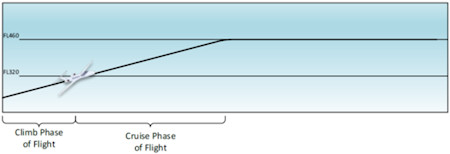Step Climbs and Capabilities
By David Rogers
Step climb functionality can be a bit confusing for pilots, even though step climbs have been a function of flight planning since the early days of FMS. This article will shed some light on the original step climb functionality as well as the new capability to plan step climbs using Honeywell’s NG FMS.
Original Step Climb Function
The original step climb functionality found in legacy flight management systems is referred to as Optimum Step Climb. This is because it attempts to optimize the flight profile by raising the aircraft’s altitude as high as possible, using the step increments specified by the crew. To calculate a step climb, the crew can enter a step climb increment in PERF INIT page 3 (See Figure 1 below). The step climb can be entered in thousands of feet or with a single number (i.e. 4,000 or 4).
Once the aircraft has the performance to reach the next altitude specified by the step increment (i.e. FL410 to FL450), it will calculate a climb and compute fuel predictions for that higher altitude. In this case a 4,000 ft. increment was specified, so it would plan to climb in 4,000 ft. increments starting from the initial cruise altitude until it reached either the aircraft ceiling or the top of descent. Once an entry is made, the FMS looks to the aircraft’s ceiling altitude found on PERF DATA page 1 (See Figure 2) and monitors the aircraft weight. When the weight is reduced such that the aircraft can make a climb by the step increment, it will direct the aircraft to the next step altitude.
 |
Figure 1. Step increment of 4,000 feet entered in PERF INIT
|
 |
Figure 3. FMS Calculating to Highest Step Altitude
In another example (see figure 4), the cruise altitude is set to FL320 and the step increment is set to 2,000 ft. The system will transition into cruise phase of flight and continue in a cruise climb until reaching the CEIL ALT (altitude at which it can no longer meet the 200 fpm climb requirement – 46,000 feet in this example).
|
 |
| Figure 6, Step Entry in Scratchpad and Figure 7, Planned Step Entered at 2R |
 |
| Figure 8. Planned Step reflected on VSD
Optimum vs. Planned Step Climbs
The primary difference between Planned and Optimum Step Climbs is that the former will coincide with a specific waypoint. Optimum Step Climbs, however, will occur anytime the FMS determines the aircraft has the performance to reach the next step climb increment as input by the crew. Optimum Step Climbs are also only available to climb the aircraft higher, while Planned Step Climbs can also facilitate descents. Also, multiple Planned Step Climbs/Descents can be programmed, which will result in accurate fuel/time predictions.
|
 |
| Figure 9. Step climbs and descents on a flight plan |


